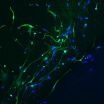(Press-News.org) A new method of generating mature nerve cells from skin cells could greatly enhance understanding of neurodegenerative diseases, and could accelerate the development of new drugs and stem cell-based regenerative medicine.
The nerve cells generated by this new method show the same functional characteristics as the mature cells found in the body, making them much better models for the study of age-related diseases such as Parkinson's and Alzheimer's, and for the testing of new drugs.
Eventually, the technique could also be used to generate mature nerve cells for transplantation into patients with a range of neurodegenerative diseases.
By studying how nerves form in developing tadpoles, researchers from the University of Cambridge were able to identify ways to speed up the cellular processes by which human nerve cells mature. The findings are reported in the May 27th edition of the journal Development.
Stem cells are our master cells, which can develop into almost any cell type within the body. Within a stem cell, there are mechanisms that tell it when to divide, and when to stop dividing and transform into another cell type, a process known as cell differentiation. Several years ago, researchers determined that a group of proteins known as transcription factors, which are found in many tissues throughout the body, regulate both mechanisms.
More recently, it was found that by adding these proteins to skin cells, they can be reprogrammed to form other cell types, including nerve cells. These cells are known as induced neurons, or iN cells. However, this method generates a low number of cells, and those that are produced are not fully functional, which is a requirement in order to be useful models of disease: for example, cortical neurons for stroke, or motor neurons for motor neuron disease.
In addition, for age-related diseases such as Parkinson's and Alzheimer's, both of which affect millions worldwide, mature nerve cells which show the same characteristics as those found in the body are crucial in order to enhance understanding of the disease and ultimately determine the best way to treat it.
"When you reprogramme cells, you're essentially converting them from one form to another but often the cells you end up with look like they come from embryos rather than looking and acting like more mature adult cells," said Dr Anna Philpott of the Department of Oncology, who led the research. "In order to increase our understanding of diseases like Alzheimer's, we need to be able to work with cells that look and behave like those you would see in older individuals who have developed the disease, so producing more 'adult' cells after reprogramming is really important."
By manipulating the signals which transcription factors send to the cells, Dr Philpott and her collaborators were able to promote cell differentiation and maturation, even in the presence of conflicting signals that were directing the cell to continue dividing.
When cells are dividing, transcription factors are modified by the addition of phosphate molecules, a process known as phosphorylation, but this can limit how well cells can convert to mature nerves. However, by engineering proteins which cannot be modified by phosphate and adding them to human cells, the researchers found they could produce nerve cells that were significantly more mature, and therefore more useful as models for disease such as Alzheimer's.
Additionally, very similar protein control mechanisms are at work to mature important cells in other tissues such as pancreatic islets, the cell type that fails to function effectively in type 2 diabetes. As well as making more mature nerves, Dr Philpott's lab is now using similar methods to improve the function of insulin-producing pancreas cells for future therapeutic applications.
"We've found that not only do you have to think about how you start the process of cell differentiation in stem cells, but you also have to think about what you need to do to make differentiation complete - we can learn a lot from how cells in developing embryos manage this," said Dr Philpott.
INFORMATION:
This research was funded by the Medical Research Council and the Rosetrees Trust.
For more information, contact:
Sarah Collins
Office of Communications, University of Cambridge
Tel: +44 (0)1223 332300 Mob: +44 (0)7525 337458
sarah.collins@admin.cam.ac.uk
Notes to editors:
The paper, "The phosphorylation status of Ascl1 is a key determinant of neuronal differentiation and maturation in vivo and in vitro." is published in the May 27th edition of the journal Development.
The Medical Research Council has been at the forefront of scientific discovery to improve human health. Founded in 1913 to tackle tuberculosis, the MRC now invests taxpayers' money in some of the best medical research in the world across every area of health. Twenty-nine MRC-funded researchers have won Nobel prizes in a wide range of disciplines, and MRC scientists have been behind such diverse discoveries as vitamins, the structure of DNA and the link between smoking and cancer, as well as achievements such as pioneering the use of randomised controlled trials, the invention of MRI scanning, and the development of a group of antibodies used in the making of some of the most successful drugs ever developed. Today, MRC-funded scientists tackle some of the greatest health problems facing humanity in the 21st century, from the rising tide of chronic diseases associated with ageing to the threats posed by rapidly mutating micro-organisms. http://www.mrc.ac.uk
Functional nerve cells from skin cells
2014-05-21
ELSE PRESS RELEASES FROM THIS DATE:
Low IQ students learn to read at 1st-grade level after persistent, intensive instruction
2014-05-21
VIDEO:
Children identified as intellectually disabled or with low IQ learned to read at a first-grade level after persistent, intensive instruction from a scientifically based curriculum. The findings of the pioneering...
Click here for more information.
The findings of a pioneering four-year educational study offer hope for thousands of children identified with intellectual disability or low IQ who have very little, if any, reading ability.
The study by researchers at Southern ...
On the road to improvement: EPA's troubled program on chemical hazards
2014-05-21
Out of the thousands of chemicals used for countless everyday products, about 500 have been assessed for potential health risks by the federal program tasked with this colossal duty. The good news is the Environmental Protection Agency, which runs the program, has improved it, but more remains to be done, according to a report from the National Research Council (NRC). Chemical & Engineering News (C&EN), the weekly news magazine of the American Chemical Society, hits the report's highlights.
Cheryl Hogue, senior correspondent for C&EN, explains that the EPA program, called ...
A new solution for storing hydrogen fuel for alternative energy
2014-05-21
Turning the "hydrogen economy" concept into a reality, even on a small scale, has been a bumpy road, but scientists are developing a novel way to store hydrogen to smooth out the long-awaited transition away from fossil fuels. Their report on a new solid, stable material that can pack in a large amount of hydrogen that can be used as a fuel appears in the ACS journal Chemistry of Materials.
Umit B. Demirci and colleagues explain that storing hydrogen in solids is a recent development and a promising step toward building a hydrogen economy. That's the idea originated ...
Paper-based diagnostics, made with a scrapbooking tool, could curb hepatitis C pandemic
2014-05-21
To the relief of patients diagnosed with hepatitis C, the U.S. Food and Drug Administration approved two new treatments late last year, and a few more are on the way. Now scientists are solving another side of the disease's problem: identifying the millions more who have the virus but don't know it — and unwittingly pass it on. A report in the ACS journal Analytical Chemistry describes a novel, scrapbook-inspired test that does just that.
Xuan Mu, Zhi Zheng and colleagues point out that the hepatitis C virus (HCV), a blood-borne pathogen that can cause liver cirrhosis, ...
Not just for the heart, red wine shows promise as cavity fighter
2014-05-21
For anyone searching for another reason to enjoy a glass of red wine with dinner, here's a good one: A new study has found that red wine, as well as grape seed extract, could potentially help prevent cavities. They say that their report, which appears in ACS' Journal of Agricultural and Food Chemistry, could lead to the development of natural products that ward off dental diseases with fewer side effects.
M. Victoria Moreno-Arribas and colleagues explain that dental diseases are extremely common throughout the world. Cavities, periodontal disease and tooth loss affect ...
University of Maryland School of Medicine research finds drugs that may treat MERS virus
2014-05-21
A team led by a University of Maryland School of Medicine (UM SOM) researcher, working as a grantee from the National Institutes of Health (NIH), has identified a number of existing drugs that could be "repurposed" to fight outbreaks of Middle East respiratory syndrome coronavirus (MERS-CoV) and severe acute respiratory syndrome coronavirus (SARS-CoV).
Clinicians treating patients suffering from MERS currently have no drugs specifically targeted to the MERS-CoV, a virus first detected in humans in 2012 that has since caused 572 laboratory-confirmed infections, including ...
Gambling history is common among homeless people in Toronto, new study
2014-05-21
TORONTO, May 21, 2014 – Homeless clients using services at Toronto's Good Shepherd Ministries are nearly nine times more likely to have a history of problem or pathological gambling than the general population, a new study from St. Michael's Hospital has found.
"Intuitively, one might think there's a connection between problem gambling and homelessness but very few studies have explored this in any depth.," said Dr. Flora Matheson, a research scientist with St. Michael's Centre for Research on Inner City Health. "By doing this kind of research, we help community organizations ...
New method for propulsion in fluids
2014-05-21
CAMBRIDGE, Mass-- Researchers at MIT have discovered a new way of harnessing temperature gradients in fluids to propel objects. In the natural world, the mechanism may influence the motion of icebergs floating on the sea and rocks moving through subterranean magma chambers.
The discovery is reported this week in the journal Physical Review Letters by associate professor of mechanical engineering Thomas Peacock and four others. The finding was an unexpected outcome of research on other effects of temperature differences, such as the way winds form over glaciers in a valley, ...
A new way to harness waste heat
2014-05-21
CAMBRIDGE, Mass-- Vast amounts of excess heat are generated by industrial processes and by electric power plants; researchers around the world have spent decades seeking ways to harness some of this wasted energy. Most such efforts have focused on thermoelectric devices, solid-state materials that can produce electricity from a temperature gradient, but the efficiency of such devices is limited by the availability of materials.
Now researchers at MIT and Stanford University have found a new alternative for low-temperature waste-heat conversion into electricity — that ...
Very distant galaxy cluster confirmed
2014-05-21
Pasadena, CA— The structures and star populations of massive galaxies appear to change as they age, but much about how these galaxies formed and evolved remains mysterious. Many of the oldest and most massive galaxies reside in clusters, enormous structures where numerous galaxies are found concentrated together. Galaxy clusters in the early universe are thought to be key to understanding the lifecycles of old galaxies, but to date astronomers have located only a handful of these rare, distant structures.
New research from a team led by Carnegie's Andrew Newman has confirmed ...


